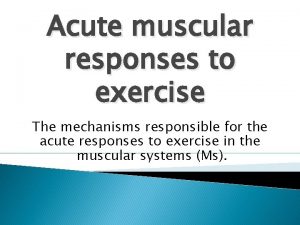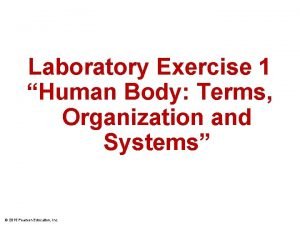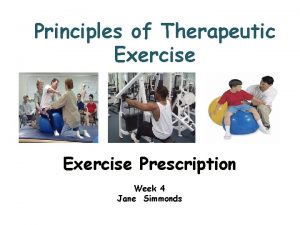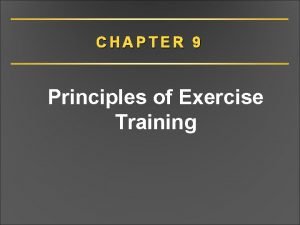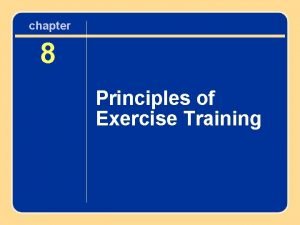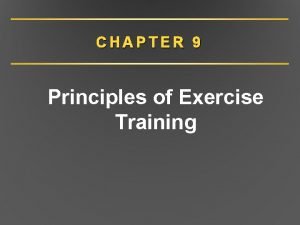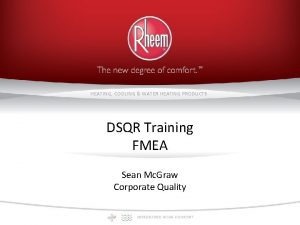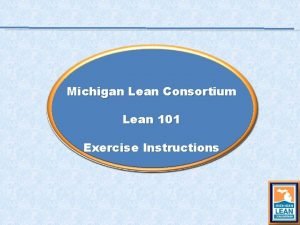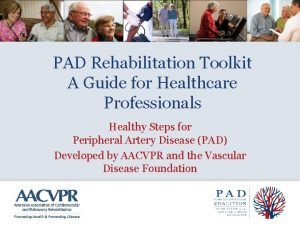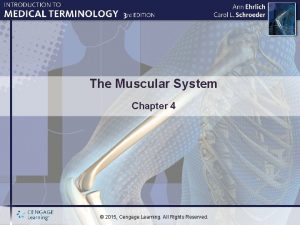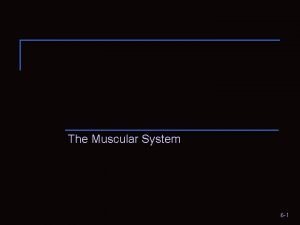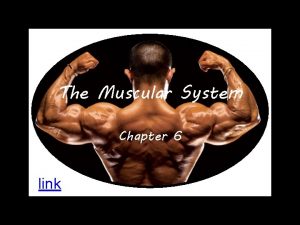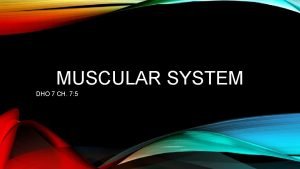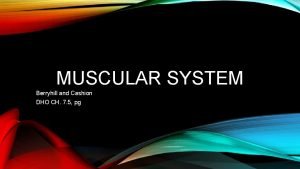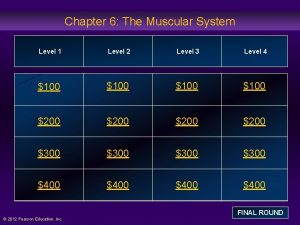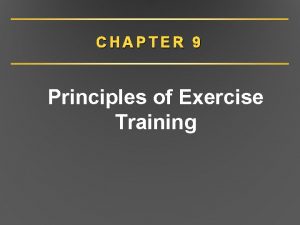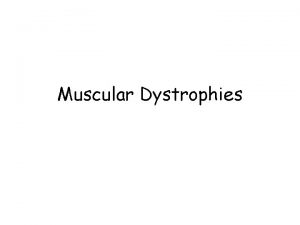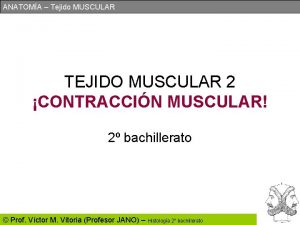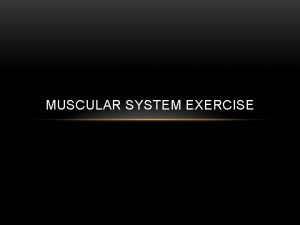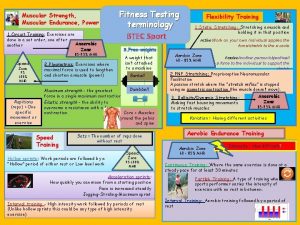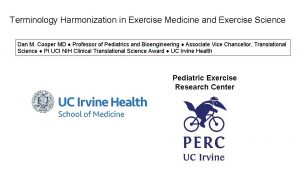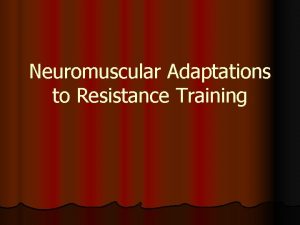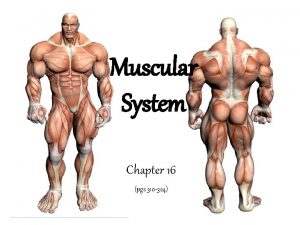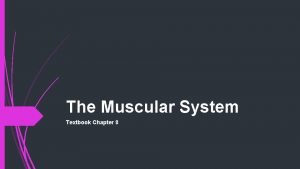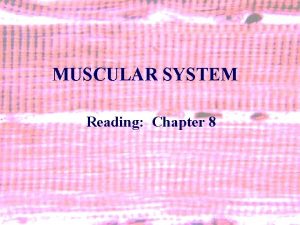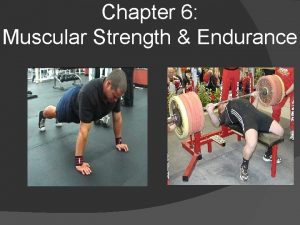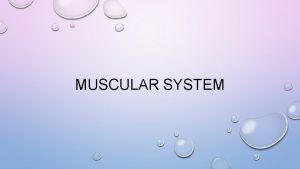CHAPTER 9 Principles of Exercise Training Terminology Muscular

























- Slides: 25

CHAPTER 9 Principles of Exercise Training



Terminology: Muscular Strength • Strength: maximal force that a muscle or muscle group can generate – Static strength – Dynamic strength (varies by speed and joint angle) • 1 repetition maximum (1 RM): maximal weight that can be lifted with a single effort – Start with proper warm-up – Add weight until only 1 repetition can be performed

Terminology: Muscular Power • Muscular power: rate of performing work – Explosive aspect of strength – Power = force x (distance/time) • Power more important than strength for many activities • Field tests not very specific to power • Typically measured with electronic devices

Terminology: Muscular Endurance • Endurance: capacity to perform repeated muscle contractions (or sustain a single contraction over time) • Number of repetitions at given % 1 RM • Increased through – Gains in muscle strength – Changes in local metabolic, cardiovascular function

Terminology: Aerobic Power • Aerobic power: rate of energy release by oxygen-dependent metabolic processes • Maximal aerobic power: maximal capacity for aerobic resynthesis of ATP – Synonyms: aerobic capacity, maximal O 2 uptake, VO 2 max – Primary limitation: cardiovascular system – Can be tested in lab or estimated from wide variety of field tests

Terminology: Anaerobic Power • Anaerobic power: rate of energy release by oxygen-independent metabolic processes • Maximal anaerobic power: maximal capacity of anaerobic systems to produce ATP – – Also known as anaerobic capacity Maximal accumulated O 2 deficit test Critical power test Wingate anaerobic test

General Principles of Training: Principle of Individuality • Not all athletes created equal • Genetics affects performance • Variations in cell growth rates, metabolism, and cardiorespiratory and neuroendocrine regulation • Explains high versus low responders

General Principles of Training: Principle of Progressive Overload • Must increase demands on body to make further improvements • Muscle overload: muscles must be loaded beyond normal loading for improvement • Progressive training: as strength , resistance/repetitions must to further strength

General Principles of Training: Principle of Specificity • Exercise adaptations specific to mode and intensity of training • Training program must stress most relevant physiological systems for given sport • Training adaptations highly specific to type of activity, training volume, and intensity

General Principles of Training: Principle of Reversibility • Use it or lose it • Training improved strength and endurance • Detraining reverses all gains

General Principles of Training: Principle of Variation • Also called principle of periodization • Systematically changes one or more variables to keep training challenging – Intensity, volume, and/or mode – Volume/ intensity • Macrocycles versus mesocycles

Resistance Training Programs: Training Needs Analysis • First appropriate step in designing and prescribing appropriate resistance training program identifies – – Muscle groups to target Type of training Energy system to stress Injury prevention needs • Specifics of resistance training program design based on needs analysis

Interaction of Loading & Reps Strength 1 2 4 Power? ? 6 8 Endurance 10 12 14 16. . Repetitions Maximum Heavy(100%) Moderate (70%) Resistance Light (50%)

Resistance Training Programs: Free Weights Versus Machines • Free weights (constant resistance) – Tax muscle extremes but not midrange – Recruit supporting and stabilizing muscles – Better for advanced weight lifters • Machines – May involve variable resistance – Safer, easier, more stable, better for novices – Limit recruitment to targeted muscle groups

Resistance Training Programs: Variable-Resistance Training • Resistance in weakest ranges of motion, in strongest ranges • Muscle works against higher percentage of its capacity at each point in range of motion • Basis for several popular machines

Resistance Training Programs: Plyometrics • Also known as stretch-shortening cycle exercise – Uses stretch reflex to recruit motor units – Stores energy during ECC, released during CON – Example: deep squat to jump to deep squat • Proposed to bridge gap between speed and strength training

Table 9. 2

Table 9. 2 (continued)

Anaerobic and Aerobic Power Training • Train sport-specific metabolic systems • Programs designed along a continuum from short sprints to long distances – Sprints: ATP-PCr (anaerobic) – Long sprint/middle distance: glycolytic (anaerobic) – Long distance: oxidative system (aerobic)

Anaerobic and Aerobic Power Training: Interval Training • Repeated bouts of high/moderate intensity interspersed with rest/reduced intensity – More total exercise performed by breaking into bouts – Same vocabulary as resistance training: sets, repetitions, time, distance, frequency, interval, rest • Example – Set 1: 6 x 400 m at 75 s (90 s slow jog) – Set 2: 6 x 800 m at 180 s (200 s jog-walk)

Anaerobic and Aerobic Power Training: Distance of Interval • Determined by requirements of activity • Sprint training: 30 to 200 m (even 400 m) • Distance training: 400 to 1, 500+ m

Anaerobic and Aerobic Power Training: Continuous Training • Training without intervals • Targets oxidative, glycolytic systems – Can be high or low intensity – High intensity near race (85 to 95% HRmax) – Low intensity: LSD training

Anaerobic and Aerobic Power Training: LSD Training • Long, slow distance • Train at ~60 to 80% HRmax (50 to 75% VO 2 max) – Popular, safe – However, must train near race pace, too • Main objective: distance, not speed – Up to 15 to 30 mi/day, 100 to 200 mi/week – Less cardiorespiratory stress – Greater joint/muscle stress, overuse injuries
 Plyometrics disadvantages
Plyometrics disadvantages Muscular system response to exercise
Muscular system response to exercise Antecubitis
Antecubitis Principles of therapeutic exercises
Principles of therapeutic exercises 9 principles of training
9 principles of training 8 principles of exercise
8 principles of exercise 9 principles of exercise
9 principles of exercise Dsqr training
Dsqr training Draw a pig standard work exercise
Draw a pig standard work exercise Raci training exercise
Raci training exercise Pad exercise training toolkit
Pad exercise training toolkit Dorsiflexion word parts
Dorsiflexion word parts Muscular system figure
Muscular system figure Rectus femoris fascicle arrangement
Rectus femoris fascicle arrangement Chapter 36 skeletal muscular and integumentary systems
Chapter 36 skeletal muscular and integumentary systems Chapter 14 the skeletal muscular and nervous systems
Chapter 14 the skeletal muscular and nervous systems Chapter 6 the muscular system figure 6-9
Chapter 6 the muscular system figure 6-9 7:5 muscular system
7:5 muscular system Chapter 9 muscular system
Chapter 9 muscular system Chapter 32 section 3 the muscular system
Chapter 32 section 3 the muscular system Microscopic anatomy of skeletal muscle figure 6-2
Microscopic anatomy of skeletal muscle figure 6-2 Chapter 7:5 muscular system
Chapter 7:5 muscular system Chapter 6 the muscular system
Chapter 6 the muscular system Matching muscle directions and positions
Matching muscle directions and positions Chapter 6 the muscular system
Chapter 6 the muscular system Chapter 6 the muscular system
Chapter 6 the muscular system

